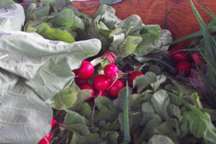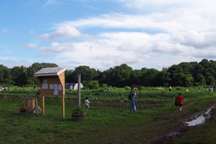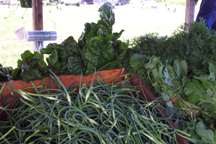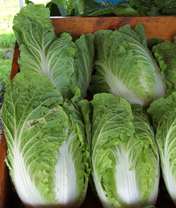Coming up at the Farm
Children's Program Sign Up
Sign Your Child Up Now! We still have a few openings in our summer Children's Learning Garden Program. Tuesdays and Thursdays, 1:30pm-4:00pm, July 7 - August 13 |
| Recipes |
Have you had a chance to try out last week's Greens recipe?! There's another one this week!
Do you have a recipe you'd like to share? Don't be shy -- let us know!
For more information, see our Recipe pages. |
| Farm Wish List |
|
5 gallon buckets, preferably with lids
Free or very low-cost massage or chiropractic practice for our hard-working farm staff
Small air compressor
|
| Meet the Bees
July 11, 11AM |
|
Interested in the local buzz? Natasha Hawke will give a tour of the beehives on the farm from 11:00AM to noon July 11th. There will be protective helmets available for anyone wanting to get up close and personal (bring your own gloves, and long sleeves/pants and don't wear black) but there will be information to hear and things to see for those who would like to keep their distance too. For anyone interested in the local honey CSA this is a good chance to speak with the beekeeper and find out more about it. This event is open and welcoming to people of all ages, however, please keep in mind that the bees need to be respected, and while they are gentle in nature, if they perceive they are being harassed or attacked they will defend their hive. It is important that anyone attending be capable of remaining quite and calm, as well as respect any boundaries given by the beekeeper. |
| Fun for the Kids |
|
Fun on the Farm, Tuesdays, 3:30 - 5:00 pm
Kids, please join us for free play, old-fashioned games, story hour (see above), nature drawing (bring supplies!) and a nut-free snack. About once a month, we'll do a special activity such as tour bee hives and chicken coops, inventory birds and insects, make cornhusk dolls and our famous Silly Olympics. Parents, nut free snack contributions would be great! Look for Anastacia near the distribution shed at 3:30.
Story Time
Boudicca Hawke (age 9) will once again do Story Time on the farm for children of all ages. It will be held each Tuesday from 4:00 to 4:45 at the meeting shelter. She will have a selection of books that are related to farms and the creatures that live on farms, however if anyone has a favorite book they'd love to share, please bring it as she will be happy to read that too. |
| CSA pickup schedule for the week
Tuesday, June 30 from 3-7 PM
Thursday, July 2 from 3-7 PM
Saturday, July 4 from 8 AM to 12 noon | |
|
What's in the share this week...
 Please note: this list is prepared the week before you receive your share. Some guesswork is involved! We do our best to predict which crops will be ready to harvest, but sometimes crops are on the list that are not in the share, and sometimes crops will be in the share even though they're not on the list. Please note: this list is prepared the week before you receive your share. Some guesswork is involved! We do our best to predict which crops will be ready to harvest, but sometimes crops are on the list that are not in the share, and sometimes crops will be in the share even though they're not on the list.
- Lettuce
- Spinach
- Green Cabbage: try grilling cabbage and scallions for a unique coleslaw
- Carrots
- Beets
- Radishes
- Endive: this variety of endive, called "Rhodos", is a delicate and tasty frisee that is a lovely complement to lettuce in salads.
- Escarole: this versatile, slightly bitter green is delicious in soups, on sandwiches, and in casseroles as well as in salads.
- Collards
- Kale
- Scallions
- Arugula
- Bunched Mustard Greens
- Mini bunching onions
- Zucchini and Summer Squash (depending on the weather)
| |
Pick-Your-Own Crops
 Shareholders are welcome to pick-your-own anytime during daylight hours. Please remember to always check the white board on the red kiosk for updated PYO information.
- Perennial herbs (including mint and thyme)
- Sugar snap peas
- Snow peas
- Flat and curly parsley
- A few sprigs of basil
- Possibly fava beans
|
Collards and Sweet Potato
Un-Southern Style
A recipe from shareholder Marla
 Collards are best known cooked southern-style - boiled with ham hock and red pepper flakes. The southern country classic "pot likker" is the leftover liquid from cooked collards. But I prefer them in a quick stir-fry, where their sweet flavor stands out and the texture is not so, well, boiled. They are very nutritious, too - and a good source of calcium for vegans.
After overhearing some shareholders at the farm stand passing by the collard greens because they were unsure what to do with them, I offer up this suggestion - collards don't have to be boiled southern-style! They have amazing flavor and retain a firmer, crunchy texture in a stir-fry. How I prepared my first collards of the season, which I served over Tinkyada rice pasta spirals
Makes enough for two (though I ate it all!), scale up to serve more.
1-2 garlic cloves or scapes, chopped
1/2 sweet potato
5-6 big collard leaves, tough part of stem removed
olive oil
tamari (soy sauce)
ume plum vinegar
- Slice out the bottom third or so of the collard stem if you have the big leaves with thick, tough stems; no need for smaller, tender stems. Lay the leaves on top of each other and roll lengthwise to make a collard "cigar" - this makes it easy to slice across for collard strips. Set aside.
- Slice sweet potato into thin discs.
Heat olive oil in pan, add garlic and after half minute or so, add the sweet potato. Cook over medium heat for about 5 minutes, until sweet potato looks mostly cooked through.
- Add collards, stirring in about a third at a time for them to wilt down a little. Cook for another 3-4 minutes, until it seems like a texture you'd like.
- Add a few splashes of tamari and a few of ume plum vinegar. Probably any vinegar you like would work here, the collards need the tang so use something you like. Taste to correct seasonings. A pinch of hot pepper flakes would not be amiss.
Enjoy! |
Notes from the Field
Stormy Weather
It just keeps on coming. Ward Cheney, an amazing farmer we  know in Concord describes it this way: "Grey, rain, mist, fog, grey, rain, showers, grey, grey, sunlight, grey, mist, rain, rain, rain, grey, fog, showers, mist, fog, grey, grey, bright, grey, rain, windy, grey, grey, rain, soggy, rain, humid, grey, rain, moldy, grey, mildew, grey, rain, rot, decay, grey, rain, sunshine, clouds, cranky, grey, thunder, lightening, clear, grey, moody, grey, weird, rain, grey, forgetful, rain, grey, foggy, nuts, grey...." It's really true. We spend days in a row moldering in our rain boots, trying to keep it together enough to kick it into high gear whenever we get a day that promises to be dry... which really means 40% chance of showers or less. know in Concord describes it this way: "Grey, rain, mist, fog, grey, rain, showers, grey, grey, sunlight, grey, mist, rain, rain, rain, grey, fog, showers, mist, fog, grey, grey, bright, grey, rain, windy, grey, grey, rain, soggy, rain, humid, grey, rain, moldy, grey, mildew, grey, rain, rot, decay, grey, rain, sunshine, clouds, cranky, grey, thunder, lightening, clear, grey, moody, grey, weird, rain, grey, forgetful, rain, grey, foggy, nuts, grey...." It's really true. We spend days in a row moldering in our rain boots, trying to keep it together enough to kick it into high gear whenever we get a day that promises to be dry... which really means 40% chance of showers or less.
A few of the consequences of this month's gloomiest June since 1903:
1. Strawberries. Abundant and delicious in the pre-season picks, ourstrawberries decided to quit right around the time that the CSA pickup season began and the rain started to fall. Our poor shareholders listed under R-Z to have had to hunt through the growing weeds for berries for three weeks -- some still have not picked a pint. Conventional farmers are worried about disease in their berries, and are trying to find a dry day to spray fungicides. Some growers are finding it hard to meet even their wholesale orders. Rainy days make it hard to pick-your-own berries, though the nice weather for the past three Saturday mornings have hopefully encouraged folks to get out to PYO farms.
2. Squash. Squash, like other fruiting crops, is dependent on pollinators to produce a squash from a squash flower. On rainy days, pollinators are limited in their ability to fly and pollinate... and you guessed the rest. Squash has both male and female flowers, and one of the saddest sights on the farm is a female squash blossom, with an attached baby squash, withering because it has not been pollinated. Even the bees who live very nearby have found it hard to get to the flowers in the weather of the past few weeks. Also, squash generally prefers warm weather to grow to an edible size, and although the past few weeks have proved that squash WILL grow in sixty degree weather, they don't like it, and the production is slow, spotty and unpredictable. Cucumbers, same deal.
3. Tomatoes and Potatoes. Our tomato and potato plants have been growing well despite the cool weather (unlike their cousins in the nightshade family, the peppers and egpplant; one extension service bulletin described these as looking like "sticks with four leaves" on many farms, and that pretty much sums it up). Unfortunately, late last week we received an email from our extension researcher letting us know that many tomato plants sold at Home Depot and Lowe's, as well as other garden centers, have been found to be infected with late blight. This is the fungal disease that contributed to the Irish famine when it wiped out the potato crops, and its virulence has not ebbed in the 160 years since. Spores of the disease travels in wind and water and wet air to tomato and potato plantings, so even though we have none of these plants growing on our own farm, we could get the disease from a neighbor's backyard tomato plants easily in weather like this. Ruth Hazzard, from the extension service, recommended that growers begin to spray fungicides immediately and spray ever 4-7 days while wet, cool weather lasts. Preventative spraying is the only option, since once the disease is present on the farm it is too late to do anything. Organic growers have the option to spray copper to prevent the disease, but copper is a powerful fungicide that eliminates all the good fungal colonies on the leaves of the plants as well as the potential disease-causing fungus. Since organically managed plants and soil should, in a healthy system, have a balance of potentially beneficial and harmful fungi and bacteria all throughout the ecosystem, using copper in this case seems a little like taking a strong antibiotic -- you do it, but only in cases of dire need, like a direct warning from your extension agent. We'll keep you posted.
4. Greens. While the wet weather causes trouble for other crops, the greens harvest continues large and beautiful. Spring crops like arugula and tatsoi continue into the first weeks of summer, while our robust summer greens, including collards, kale, and Swiss chard, look to be around for a while to come. Enjoy them while they last -- it's bound to warm up sometime... right?
Amanda, for the farm staff
| |
|
Warmly,
The Staff of Waltham Fields Community Farm
|
Jericho Bicknell, Education and Outreach Coordinator
Amanda Cather, Farm Manager
Amanda Dumont, Field Crew
Debra Guttormsen, Administrative and Finance Coordinator
Paula Jordan, Spring & Fall Children's Learning Garden Assistant
Sarah Kielsmeier-Jones, Field Crew
Jonathan Martinez, Assistant Grower
Blake Roberts, Outreach Market Intern
Dan Roberts, Assistant Grower Erinn Roberts, Assistant Grower Nina Rogowsky, Children's Learning Garden Teacher Andy Scherer, Assistant Farm Manager Lina Yamashita, Summer Children's Learning Garden Assistant | |
|